Your monthly guide to Galapagos’ unique fauna
Having been isolated from the mainland for thousands of years, wildlife in the Galapagos Islands has evolved in unique and fascinating ways. These endemic animals continue to inspire visitors today as they did Charles Darwin back in 1835. Giant tortoises, playful sea lions, tiny penguins, blue-footed boobies, and marine iguanas are some of the most captivating and sought-after species.
Most of the animals that we can find in the Galapagos are visible throughout the year. Still, some events only occur at certain times of the year and on some specific islands. If you want to see the albatross on land, it is better to prepare your trip between March and December with an itinerary that includes Española Island. If your interest is in Galapagos penguins, you better embark on an itinerary through the western part of the archipelago.
In this article, you will find a calendar with the different events related to the most picturesque animals in the Galapagos:
January
January is the breeding season for marine iguanas, and it is when we can see males with green and reddish colors on their skin to attract the female of the species. Marine iguanas are distributed throughout the archipelago, but the best place to see them is on Fernandina Island, home to the largest colony of marine iguanas.
 During this month, if luck favors us, we can also see sea turtles as they make their yearly pilgrimage to lay their eggs on the beaches of the same island where they were born.
February
February marks the beginning of the flamingo nesting season on Floreana Island. Flamingos gather in groups to perform an elaborate dance and display their bright pink primary feathers as part of their mating ritual. Witnessing this ritual is a truly unforgettable experience.
During this month, if luck favors us, we can also see sea turtles as they make their yearly pilgrimage to lay their eggs on the beaches of the same island where they were born.
February
February marks the beginning of the flamingo nesting season on Floreana Island. Flamingos gather in groups to perform an elaborate dance and display their bright pink primary feathers as part of their mating ritual. Witnessing this ritual is a truly unforgettable experience.
 March
In March, the Galapagos albatross begins to return to Isla Española after several months away. With a wingspan of up to 2.5 meters (8.2 feet), it is the largest seabird in the world. This bird can only be found on Española Island on the eastern end of the archipelago.
March
In March, the Galapagos albatross begins to return to Isla Española after several months away. With a wingspan of up to 2.5 meters (8.2 feet), it is the largest seabird in the world. This bird can only be found on Española Island on the eastern end of the archipelago.
 April
The first sea turtle hatchlings begin to emerge in April. At night, hundreds of small turtles can be seen crossing the beach. Pacific green sea turtles can be found on the beaches of Isabela and Fernandina islands.
April
The first sea turtle hatchlings begin to emerge in April. At night, hundreds of small turtles can be seen crossing the beach. Pacific green sea turtles can be found on the beaches of Isabela and Fernandina islands.
 May
In May, birdwatchers can witness the peculiar mating ritual of blue-footed boobies. The male will display his feet in a carefully choreographed dance. The color of its feet is of particular importance when searching for a mate since its pigmentation is an indicator of how well it can feed. One of the best places to observe this dance is North Seymour Island.
May
In May, birdwatchers can witness the peculiar mating ritual of blue-footed boobies. The male will display his feet in a carefully choreographed dance. The color of its feet is of particular importance when searching for a mate since its pigmentation is an indicator of how well it can feed. One of the best places to observe this dance is North Seymour Island.
 June
In June, the dances of the blue-footed boobies on North Seymour Island coincide with the frigate mating season. During this time, the flashy males begin to puff their giant red pouches, stretching from their beaks to their chests.
June
In June, the dances of the blue-footed boobies on North Seymour Island coincide with the frigate mating season. During this time, the flashy males begin to puff their giant red pouches, stretching from their beaks to their chests.
 July
Although it is quite likely to see dolphins in the Galapagos at any time of the year, the water temperature makes them get closer to the Galapagos coast during the summer months. July offers the best opportunity to see whales and dolphins in the Galapagos, especially between the channel that separates the Fernandina and Isabela islands, only accessible through cruises. 24 species of dolphins and whales call the Galapagos Marine Reserve home, including orcas, humpback whales and bottlenose dolphins.
July
Although it is quite likely to see dolphins in the Galapagos at any time of the year, the water temperature makes them get closer to the Galapagos coast during the summer months. July offers the best opportunity to see whales and dolphins in the Galapagos, especially between the channel that separates the Fernandina and Isabela islands, only accessible through cruises. 24 species of dolphins and whales call the Galapagos Marine Reserve home, including orcas, humpback whales and bottlenose dolphins.
 August
August marks the start of the Galapagos hawk’s breeding season. One of the largest birds in the archipelago, this species of falcon can be found on the islands of Española, Santiago, and Fernandina.
August
August marks the start of the Galapagos hawk’s breeding season. One of the largest birds in the archipelago, this species of falcon can be found on the islands of Española, Santiago, and Fernandina.
 September
Although Galapagos penguins inhabit the western islands throughout the year, they are closer to the central islands, such as Bartolomé or Santiago, during this time.
September
Although Galapagos penguins inhabit the western islands throughout the year, they are closer to the central islands, such as Bartolomé or Santiago, during this time.
 Of the 18 penguin species in the world, Galapagos penguins are the smallest, weighing around two kilograms. It is the only species of penguins that can be found north of the Equator.
October
Breeding of the Galapagos fur seals begins in October and continues until December. It is possible to see groups of this species so unique in the Fernandina and Isabela Islands, but, above all, in Santiago.
Of the 18 penguin species in the world, Galapagos penguins are the smallest, weighing around two kilograms. It is the only species of penguins that can be found north of the Equator.
October
Breeding of the Galapagos fur seals begins in October and continues until December. It is possible to see groups of this species so unique in the Fernandina and Isabela Islands, but, above all, in Santiago.
 During this month, we also start seeing blue-footed boobies raising their newborn chicks on North Seymour Island.
November
As the seas begin to calm down and the water temperature rises, we will be able to enjoy excellent visibility when snorkeling or diving. Sealion cubs will be several months old and are at their most playful stage, approaching swimmers to play with them. Some of the best places to snorkel on the islands are Devil’s Crown, Kicker Rock, Punta Espinoza, or Tagus Cove.
During this month, we also start seeing blue-footed boobies raising their newborn chicks on North Seymour Island.
November
As the seas begin to calm down and the water temperature rises, we will be able to enjoy excellent visibility when snorkeling or diving. Sealion cubs will be several months old and are at their most playful stage, approaching swimmers to play with them. Some of the best places to snorkel on the islands are Devil’s Crown, Kicker Rock, Punta Espinoza, or Tagus Cove.
 December
One of the most exciting natural events occurs between December and March: the hatching of giant tortoises. Weighing up to 250 kg (550 lb.), the Galapagos giant tortoise is the largest living tortoise species in the world. They grow very slowly and often live for more than 100 years.
December
One of the most exciting natural events occurs between December and March: the hatching of giant tortoises. Weighing up to 250 kg (550 lb.), the Galapagos giant tortoise is the largest living tortoise species in the world. They grow very slowly and often live for more than 100 years.
 Carlos Beate is the Commercial Manager at Andando Tours. Andando Tours offers exclusive traveling experiences, specializing in sailing around the Galapagos Islands and overland along the magnificent Avenue of Volcanoes on the Ecuadorian Andes.
If you would like to be a guest blogger on A Luxury Travel Blog in order to raise your profile, please contact us.
Carlos Beate is the Commercial Manager at Andando Tours. Andando Tours offers exclusive traveling experiences, specializing in sailing around the Galapagos Islands and overland along the magnificent Avenue of Volcanoes on the Ecuadorian Andes.
If you would like to be a guest blogger on A Luxury Travel Blog in order to raise your profile, please contact us.
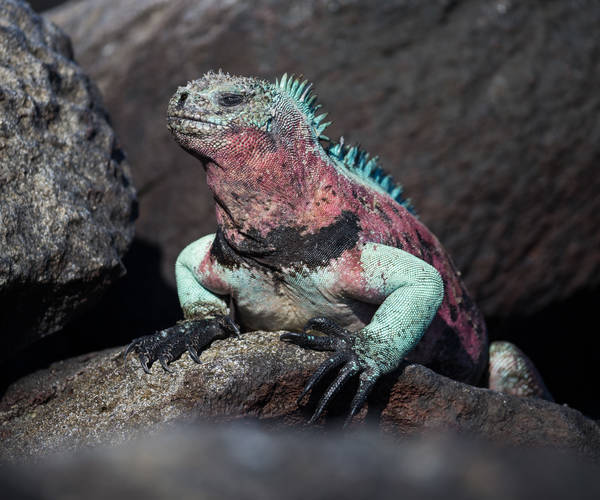 During this month, if luck favors us, we can also see sea turtles as they make their yearly pilgrimage to lay their eggs on the beaches of the same island where they were born.
February
February marks the beginning of the flamingo nesting season on Floreana Island. Flamingos gather in groups to perform an elaborate dance and display their bright pink primary feathers as part of their mating ritual. Witnessing this ritual is a truly unforgettable experience.
During this month, if luck favors us, we can also see sea turtles as they make their yearly pilgrimage to lay their eggs on the beaches of the same island where they were born.
February
February marks the beginning of the flamingo nesting season on Floreana Island. Flamingos gather in groups to perform an elaborate dance and display their bright pink primary feathers as part of their mating ritual. Witnessing this ritual is a truly unforgettable experience.
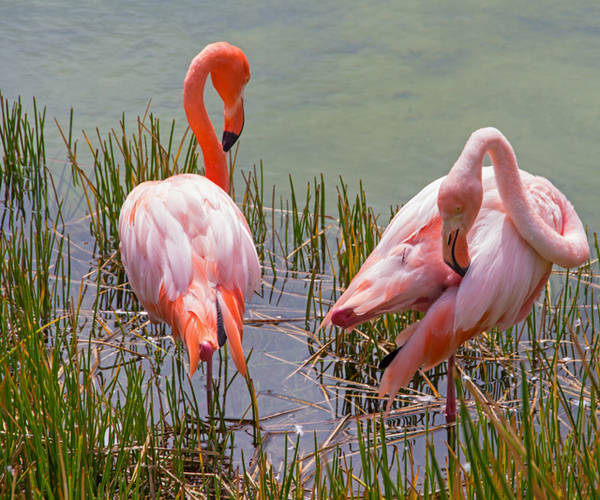 March
In March, the Galapagos albatross begins to return to Isla Española after several months away. With a wingspan of up to 2.5 meters (8.2 feet), it is the largest seabird in the world. This bird can only be found on Española Island on the eastern end of the archipelago.
March
In March, the Galapagos albatross begins to return to Isla Española after several months away. With a wingspan of up to 2.5 meters (8.2 feet), it is the largest seabird in the world. This bird can only be found on Española Island on the eastern end of the archipelago.
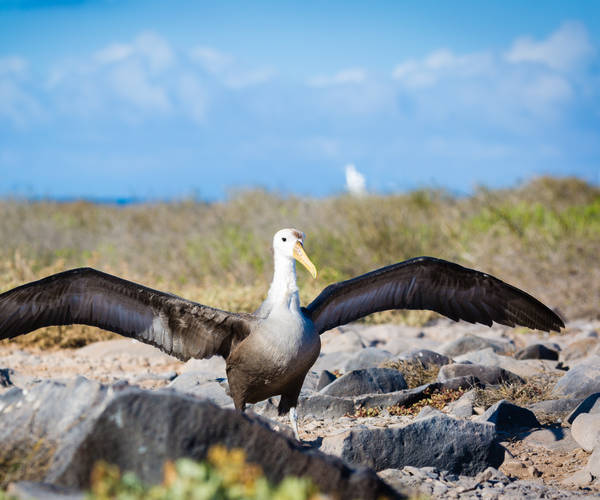 April
The first sea turtle hatchlings begin to emerge in April. At night, hundreds of small turtles can be seen crossing the beach. Pacific green sea turtles can be found on the beaches of Isabela and Fernandina islands.
April
The first sea turtle hatchlings begin to emerge in April. At night, hundreds of small turtles can be seen crossing the beach. Pacific green sea turtles can be found on the beaches of Isabela and Fernandina islands.
 May
In May, birdwatchers can witness the peculiar mating ritual of blue-footed boobies. The male will display his feet in a carefully choreographed dance. The color of its feet is of particular importance when searching for a mate since its pigmentation is an indicator of how well it can feed. One of the best places to observe this dance is North Seymour Island.
May
In May, birdwatchers can witness the peculiar mating ritual of blue-footed boobies. The male will display his feet in a carefully choreographed dance. The color of its feet is of particular importance when searching for a mate since its pigmentation is an indicator of how well it can feed. One of the best places to observe this dance is North Seymour Island.
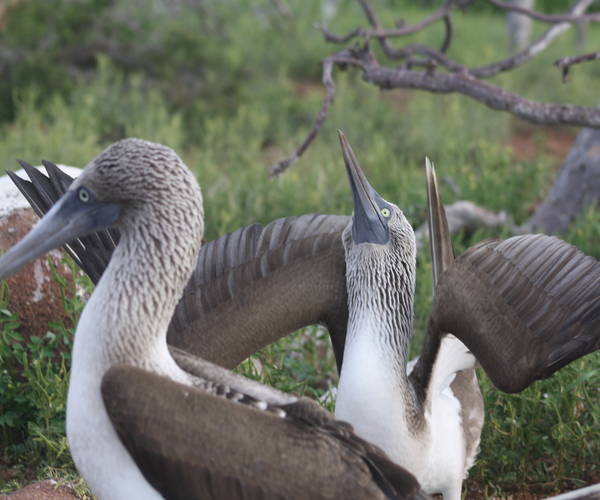 June
In June, the dances of the blue-footed boobies on North Seymour Island coincide with the frigate mating season. During this time, the flashy males begin to puff their giant red pouches, stretching from their beaks to their chests.
June
In June, the dances of the blue-footed boobies on North Seymour Island coincide with the frigate mating season. During this time, the flashy males begin to puff their giant red pouches, stretching from their beaks to their chests.
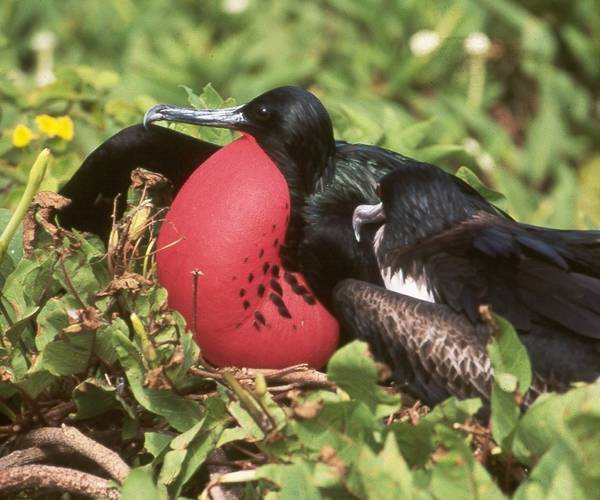 July
Although it is quite likely to see dolphins in the Galapagos at any time of the year, the water temperature makes them get closer to the Galapagos coast during the summer months. July offers the best opportunity to see whales and dolphins in the Galapagos, especially between the channel that separates the Fernandina and Isabela islands, only accessible through cruises. 24 species of dolphins and whales call the Galapagos Marine Reserve home, including orcas, humpback whales and bottlenose dolphins.
July
Although it is quite likely to see dolphins in the Galapagos at any time of the year, the water temperature makes them get closer to the Galapagos coast during the summer months. July offers the best opportunity to see whales and dolphins in the Galapagos, especially between the channel that separates the Fernandina and Isabela islands, only accessible through cruises. 24 species of dolphins and whales call the Galapagos Marine Reserve home, including orcas, humpback whales and bottlenose dolphins.
 August
August marks the start of the Galapagos hawk’s breeding season. One of the largest birds in the archipelago, this species of falcon can be found on the islands of Española, Santiago, and Fernandina.
August
August marks the start of the Galapagos hawk’s breeding season. One of the largest birds in the archipelago, this species of falcon can be found on the islands of Española, Santiago, and Fernandina.
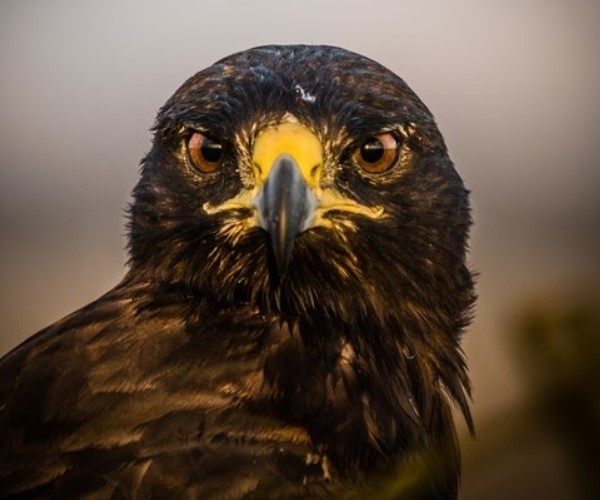 September
Although Galapagos penguins inhabit the western islands throughout the year, they are closer to the central islands, such as Bartolomé or Santiago, during this time.
September
Although Galapagos penguins inhabit the western islands throughout the year, they are closer to the central islands, such as Bartolomé or Santiago, during this time.
 Of the 18 penguin species in the world, Galapagos penguins are the smallest, weighing around two kilograms. It is the only species of penguins that can be found north of the Equator.
October
Breeding of the Galapagos fur seals begins in October and continues until December. It is possible to see groups of this species so unique in the Fernandina and Isabela Islands, but, above all, in Santiago.
Of the 18 penguin species in the world, Galapagos penguins are the smallest, weighing around two kilograms. It is the only species of penguins that can be found north of the Equator.
October
Breeding of the Galapagos fur seals begins in October and continues until December. It is possible to see groups of this species so unique in the Fernandina and Isabela Islands, but, above all, in Santiago.
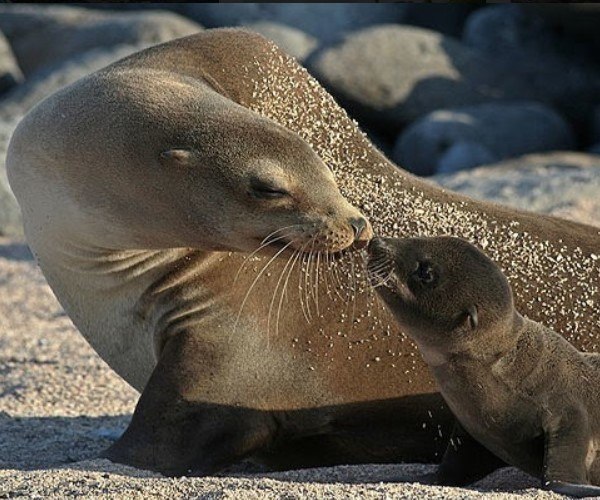 During this month, we also start seeing blue-footed boobies raising their newborn chicks on North Seymour Island.
November
As the seas begin to calm down and the water temperature rises, we will be able to enjoy excellent visibility when snorkeling or diving. Sealion cubs will be several months old and are at their most playful stage, approaching swimmers to play with them. Some of the best places to snorkel on the islands are Devil’s Crown, Kicker Rock, Punta Espinoza, or Tagus Cove.
During this month, we also start seeing blue-footed boobies raising their newborn chicks on North Seymour Island.
November
As the seas begin to calm down and the water temperature rises, we will be able to enjoy excellent visibility when snorkeling or diving. Sealion cubs will be several months old and are at their most playful stage, approaching swimmers to play with them. Some of the best places to snorkel on the islands are Devil’s Crown, Kicker Rock, Punta Espinoza, or Tagus Cove.
 December
One of the most exciting natural events occurs between December and March: the hatching of giant tortoises. Weighing up to 250 kg (550 lb.), the Galapagos giant tortoise is the largest living tortoise species in the world. They grow very slowly and often live for more than 100 years.
December
One of the most exciting natural events occurs between December and March: the hatching of giant tortoises. Weighing up to 250 kg (550 lb.), the Galapagos giant tortoise is the largest living tortoise species in the world. They grow very slowly and often live for more than 100 years.
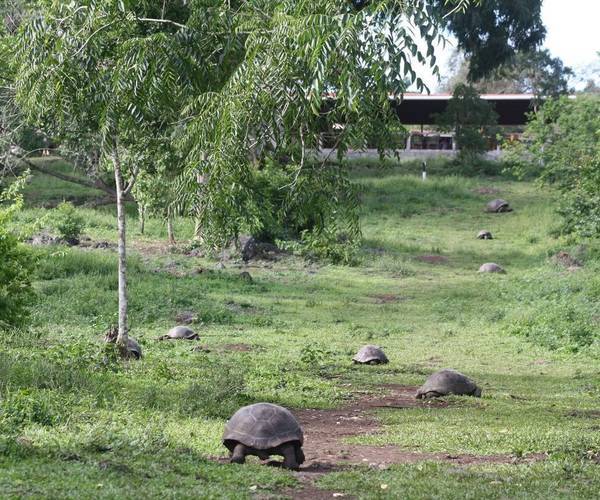 Carlos Beate is the Commercial Manager at Andando Tours. Andando Tours offers exclusive traveling experiences, specializing in sailing around the Galapagos Islands and overland along the magnificent Avenue of Volcanoes on the Ecuadorian Andes.
If you would like to be a guest blogger on A Luxury Travel Blog in order to raise your profile, please contact us.
Carlos Beate is the Commercial Manager at Andando Tours. Andando Tours offers exclusive traveling experiences, specializing in sailing around the Galapagos Islands and overland along the magnificent Avenue of Volcanoes on the Ecuadorian Andes.
If you would like to be a guest blogger on A Luxury Travel Blog in order to raise your profile, please contact us.Did you enjoy this article?
Receive similar content direct to your inbox.


A monthly guide is really useful. The Galápagos Islands are on my travel list. But deciding what time of the year to visit is going to be an issue so this is very helpful.
That’s one of the most important things I’ve learned about traveling. The experience you can have is totally based on the time of the year. It helps for something like this, or when tourist season is a little low so prices tend to be cheap. I wonder if that same concept works here.
I’m a very regular visitor to A Luxury Travel
Blog but I’ve never seen a monthly guide to wildlife before. It’s a great original idea. Maybe some of the African bloggers could do something similar on Africa wildlife? It would be once to know when the good times to go on safari are.
I’m a very regular visitor to A Luxury Travel Blog but I don’t think that I’ve seen a monthly wildlife guide before. It’s a great idea. Maybe some of the Africa bloggers could do something similar?
12 great photos of Galápagos wildlife. Any of the would make a great “Visit the Galapagos” poster. Well, maybe not the giant tortoises one to start with but perhaps with some digital manipulation it would look good.
Sadly the best I can do is to say that I’ve seen some of these beautiful creatures in zoos and aquariums which is a pretty poor substitute for seeing them in the wild in their natural environment. Once we can start travelling again I ought to try to get to the Galápagos, it would definitely be the trip of a lifetime.
I’ve only seen flamingos and penguins once and I absolutely loved the experience. They’re actually both so unusual when you really study them. It would be incredible to see such variety of animals here and I bet you’d come back from the Galapagos with thousands of photos to treasure. There’s something very grounding about wildlife, very humbling too.
It’s interesting to learn a bit more about what happens when during the year. I guess if you have a particular interest and are dying to see something specific, like the hatching of the giant tortoises (which I’d also be curious to witness!) then you can better plan your trip. I tend to pick summer time for most holidays but that’s not always the best option, it depends on what’s happening there, what the natural wildlife are up to, prices and so on, so it’s a great idea to share this sort of helpful guide.
I can’t think of a better place anywhere in the world to go and see wildlife. I know that’s true about Madagascar as well. I love that we can learn more about nature in these kinds of places. It must be such a different life experience to live in a faraway place like the Galapagos Islands. So much history there based on science and evolution.
These iguanas are really colorful but really not my thing. I cringe. And I’ve only seen flamingos in a zoo. It would be refreshing to see them in the wild like a pink cloud on the ground. I wonder how’s the weather during the “ber” months as I’m more of a water person and would be very interested in swimming with sea lions or seeing the giant tortoises. But I’m sure any month in Galapagos would be filled with colorful flora and fauna.
This is really cool, I like the format. It makes for an interesting read. I can even see this type of layout more engrossing as a longer piece with some greater depth or details. I loved reading about the different animals this way.
The Nasca Boobies and Christmas Iguanas are my absolute favorites. Thanks for publishing this about my home in the Galapagos Islands! I live here all year long on San Cristobol and during Covid quarentine we have had some time to allow our kids to be one with the local Flora and Fauna.
As we are thinking about a visit to the Galapagos sometime in 2023, I remembered reading this post. Going through month by month is a great source of information as it should help us to decide when the best month for us to visit would be.